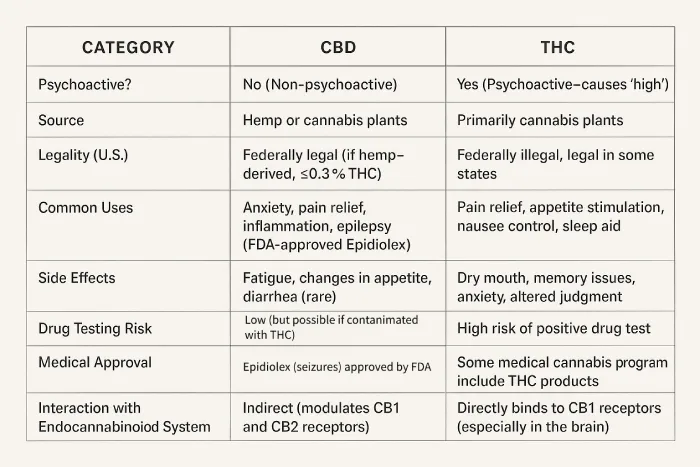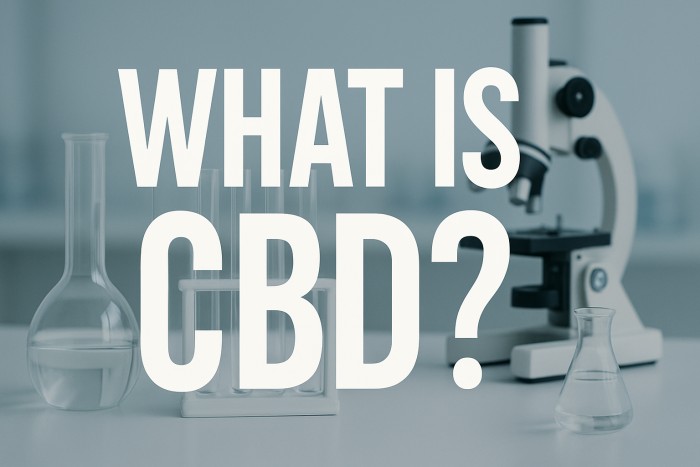This guide explores what CBD is, how it works, its potential benefits, legal status, safety considerations, and the current state of research, providing a thorough resource for understanding this complex compound.
Understanding CBD: A Comprehensive Overview
- Definition: Cannabidiol (CBD) is a non-psychoactive compound found in cannabis and hemp plants, distinct from THC, which causes a high.
- Potential Benefits: Research suggests CBD may help with epilepsy, pain, anxiety, and inflammation, though evidence is limited for many uses.
- Legal Status: In the U.S., hemp-derived CBD with less than 0.3% THC is federally legal, but regulations vary by state and country.
- Safety: Generally well-tolerated, but side effects like drowsiness or diarrhea may occur, and product quality can be inconsistent.
- Controversy: The CBD market faces challenges with mislabeling and unproven health claims, prompting caution from health authorities.
What is CBD?
CBD, short for cannabidiol, is one of over 100 cannabinoids produced by the cannabis plant.
It is most commonly extracted from hemp — a variety of Cannabis sativa bred to contain high CBD and low THC levels (<0.3%).
CBD products include oils, edibles, capsules, topicals, and prescription medications like Epidiolex.
Why is CBD Popular?
CBD gained rapid popularity due to its perceived potential to address conditions such as epilepsy, chronic pain, anxiety, and sleep disorders.
In 2018, the FDA approved Epidiolex, a CBD-based medication for rare seizure disorders, confirming at least one medical use.
Since then, consumer demand has exploded across wellness and alternative medicine markets, despite limited large-scale clinical evidence for other conditions.
Is CBD Safe and Legal?
CBD is generally considered safe, with side effects like dry mouth or fatigue being mild for most users.
However, it can interact with medications, and product quality varies widely, with some containing incorrect CBD levels or traces of THC.
Legally, hemp-derived CBD is permitted in the U.S. under the 2018 Farm Bill, but state laws differ, and international regulations range from permissive to prohibitive.
Always check local laws and consult a doctor before use.

CBD Vs. THC: Key Differences
| Aspect | CBD | THC |
|---|---|---|
| Psychoactive? | No | Yes (produces a “high”) |
| Legal Status | Legal if hemp-derived and <0.3% THC (U.S.) | Restricted/illegal in many areas |
| Primary Uses | Wellness, anxiety, epilepsy, inflammation | Recreation, pain management, appetite stimulation |
CBD and THC are both cannabinoids, chemical compounds derived from the cannabis plant, but they have distinct effects on the body
CBD interacts with the endocannabinoid system (ECS) differently than THC, producing therapeutic effects without intoxication (Healthline).
THC is responsible for the euphoric, psychoactive effects associated with cannabis use, often referred to as a “high.”
In contrast, CBD is non-psychoactive and is believed to offer benefits such as pain relief, reduced anxiety, and anti-inflammatory effects without altering mental state.
This distinction makes CBD appealing for medical and wellness applications, particularly for individuals who wish to avoid psychoactive effects (Healthline).
Source: Cannabis Vs. Hemp
CBD can be extracted from both cannabis and hemp, two varieties of the Cannabis sativa plant.
Hemp contains high levels of CBD and low levels of THC (less than 0.3%), making it the preferred source for most CBD products due to its legal status and minimal psychoactive potential.
Cannabis, often referred to as marijuana, typically has higher THC content, which can complicate its use for CBD extraction due to legal restrictions and the presence of psychoactive compounds.
Understanding the source of CBD is critical, as it affects both the product’s legality and its composition (CDC).
How CBD Works
CBD interacts with the body’s endocannabinoid system (ECS), a complex network of receptors, endocannabinoids, and enzymes that helps regulate processes like pain, mood, sleep, and immune function.
The ECS includes two main receptors:
- CB1 receptors: Found mainly in the brain and nervous system.
- CB2 receptors: Found in immune cells and peripheral tissues.
Unlike THC, which binds directly to these receptors, CBD has a lower affinity and acts as a modulator, influencing receptor activity indirectly (Neuropharmacology).
Medical Uses and Benefits
CBD has been studied for its potential therapeutic applications, with some uses supported by stronger evidence than others.
Below are the key areas of interest:
Epilepsy
The most robust evidence for CBD’s medical use is in treating epilepsy.
The U.S. Food and Drug Administration (FDA) has approved Epidiolex, a CBD-based oral solution, for seizures associated with Dravet syndrome, Lennox-Gastaut syndrome, and tuberous sclerosis complex in patients one year and older (FDA Approval).
Clinical trials have demonstrated significant reductions in seizure frequency, making CBD a groundbreaking treatment for these rare conditions.
Pain Management
Research suggests CBD may help manage chronic pain by reducing inflammation and modulating pain signals.
A 2015 study on rats showed CBD reduced arthritis-related pain and inflammation (Study).
Human studies are less conclusive, but anecdotal reports and preliminary data indicate potential for conditions like neuropathic pain and fibromyalgia.
Anxiety and Depression
CBD may have anxiolytic (anxiety-reducing) and antidepressant effects, possibly due to its interaction with serotonin receptors.
A 2019 study found CBD reduced anxiety in individuals with social anxiety disorder, though larger trials are needed to confirm these findings.
Early research also suggests potential benefits for depression, but evidence remains limited.
Other Potential Uses
- Insomnia: Some studies indicate CBD may improve sleep quality, potentially by reducing anxiety or pain (Healthline).
- Inflammation: CBD’s anti-inflammatory properties may benefit conditions like inflammatory bowel disease or arthritis (Study).
- Cancer Treatment Side Effects: CBD may alleviate nausea, pain, and appetite loss associated with chemotherapy, according to the American Cancer Society (Cancer and CBD).
- Neurological Disorders: Ongoing research explores CBD’s potential for multiple sclerosis, Parkinson’s disease, and addiction, but high-quality evidence is lacking (AAMC).
While these applications are promising, many claims about CBD’s benefits are not yet fully supported by rigorous scientific evidence, and more research is needed to establish its efficacy and optimal use.
Legal Status
The legal status of CBD is complex and varies globally, creating challenges for consumers and manufacturers.
United States
The 2018 Farm Bill legalized hemp and hemp-derived CBD containing less than 0.3% THC at the federal level (Farm Bill).
However, the FDA regulates CBD products and has not approved non-prescription CBD for use in food, dietary supplements, or animal feed, citing safety and efficacy concerns.
Marketing CBD with unproven health claims is illegal, and Epidiolex remains the only FDA-approved CBD product (FDA Warnings).
State laws vary, with some allowing broader use and others imposing stricter regulations.
International Perspectives
- Canada: CBD is legal for recreational and medical use under the Cannabis Act, with strict production and sales regulations (Health Canada).
- European Union: CBD is classified as a “novel food,” requiring safety assessments before sale (EFSA Ruling).
- Australia: CBD is a prescription-only medication, with proposals for low-dose over-the-counter access (TGA Review).
Consumers should verify local regulations before purchasing or traveling with CBD products.

Forms and Consumption Methods
CBD is available in a variety of forms, each suited to different needs and preferences:
| Form | Description | Best For |
|---|---|---|
| Oils/Tinctures | Liquid CBD taken orally or sublingually for rapid absorption. | General use, precise dosing |
| Edibles | Gummies, chocolates, or beverages ingested orally, with slower onset. | Convenience, discreet use |
| Topicals | Creams, lotions, or balms applied to the skin for localized relief. | Pain, inflammation, skin issues |
| Capsules | Pre-measured oral pills for consistent dosing. | Daily supplementation |
| Vaping | Inhaled CBD e-liquids for fast absorption, but potential respiratory risks. | Rapid relief, experienced users |
| Prescription | Medications like Epidiolex for specific medical conditions. | Epilepsy, medical supervision |
Dosage: Start with a low dose (e.g., 5-10 mg) and adjust gradually, as individual responses vary.
A 2019 study found that a single dose of CBD up to 6,000mg was well tolerated.
Most studies used a CBD dose between 20 and 1,500mg, but most users require far less.
Consult a healthcare provider for personalized guidance, especially for those with liver conditions or taking other medications.
Safety and Side Effects
CBD is generally well-tolerated, but side effects can occur, particularly at higher doses.
Common side effects include:
- Dry mouth
- Diarrhea
- Reduced appetite
- Drowsiness
- Fatigue
CBD can interact with medications, such as blood thinners, by affecting liver enzymes like CYP3A4, potentially altering drug metabolism (Drug Interactions).
The FDA has raised concerns about potential liver toxicity, effects on male fertility, and risks during pregnancy or breastfeeding (FDA Concerns).
Product Quality Issues
The CBD market is poorly regulated, leading to widespread mislabeling.
The 2017 study titled “Labeling Accuracy of Cannabidiol Extracts Sold Online” analyzed 84 CBD products from 31 companies.
The findings were:
- 42.85% of products were under-labeled (contained more CBD than indicated).
- 26.19% were over-labeled (contained less CBD than indicated).
- 30.95% were accurately labeled (within ±10% of the stated amount).
- 21.43% of products contained detectable levels of THC.
In 2019, U.S. poison control centers reported 1,085 CBD-related cases, with over 33% requiring medical attention.
To ensure safety:
- Choose products with a recent Certificate of Analysis (COA) from third-party labs (Reading Labels).
- Avoid products with unverified health claims.
- Purchase from reputable manufacturers with transparent testing practices.
Research and Future Directions
While CBD shows promise, much of the research is preliminary, and large-scale, high-quality clinical trials are needed to confirm its efficacy and safety.
Current research focuses on:
- Neurological Disorders: Expanding on epilepsy findings to explore Parkinson’s, multiple sclerosis, and Alzheimer’s.
- Mental Health: Investigating CBD’s potential for anxiety, depression, addiction, and psychosis.
- Chronic Pain: Evaluating CBD’s role in arthritis, neuropathic pain, and fibromyalgia.
- Inflammation and Autoimmune Diseases: Assessing anti-inflammatory effects for conditions like Crohn’s disease.
Challenges include federal restrictions in the U.S., which limit research funding and access to standardized CBD.
Veterinary research is also growing, with studies showing potential benefits for canine osteoarthritis and epilepsy, though no registered CBD products exist for pets (Veterinary Studies).
Future directions may include developing standardized dosing guidelines, exploring CBD’s synergistic effects with other compounds, and clarifying its long-term safety profile.
As research progresses, CBD’s role in medicine and wellness will become clearer.
Society and Culture
CBD has permeated popular culture, appearing in foods, beverages, and even sports.
A 2023 Healthline survey found that 25% of U.S. adults have tried or are interested in CBD, with edibles like gummies being the most popular (CBD Survey).
In sports, the World Anti-Doping Agency removed CBD from its banned substances list, leading to its use by athletes for pain management (Athlete Use).
However, the industry faces challenges, including a market collapse in 2024 due to inconsistent regulations and investor withdrawal.
Conclusion
CBD is a multifaceted compound with significant potential for medical and wellness applications, particularly for epilepsy, pain, and anxiety.
However, its benefits are not fully substantiated for many conditions, and the market’s lack of regulation poses risks of mislabeling and contamination.
Consumers should approach CBD with informed caution, selecting high-quality products, checking local laws, and consulting healthcare providers, especially if taking other medications.
As research advances, CBD’s therapeutic role will likely become more defined, offering new possibilities for health and well-being.
Key Citations
- Cannabidiol (CBD) Wikipedia Overview
- Mayo Clinic: Is CBD Safe and Effective?
- Healthline: What Is Cannabidiol (CBD)? Uses, Benefits
- Harvard Health: Cannabidiol (CBD) What We Know
- CDC: About CBD and Public Health
- WebMD: Cannabidiol (CBD) Overview and Uses
- FDA: Approval of Epidiolex for Seizures
- 2018 Farm Bill Legalizing Hemp
- FDA Warnings on CBD Marketing Claims
- State Medical Marijuana Laws
- 2015 Study on CBD for Arthritis Pain
- 2014 Study on CBD Anti-Inflammatory Effects
- American Cancer Society: Marijuana and Cancer
- Health Canada: Cannabidiol Regulations
- EFSA: CBD as Novel Food
- TGA: Safety of Low-Dose CBD
- Hong Kong CBD Ban Proposal
- 2017 Study on CBD Product Mislabeing
- Healthline: Reading a CBD Label
- Healthline: CBD and Drug Interactions
- Healthline: CBD Dosage Guidelines
- 2021 Study on CBD Maximum Dosage
- 2019 Study on CBD for Canine Epilepsy
- USADA: Six Things to Know About CBD
- Healthline: 2023 CBD Usage Survey
About The Author
Joseph Powers is the founder of Legal CBD Idaho and a trusted voice in Idaho’s hemp and CBD space. With over a decade of experience in cannabis compliance and education, Joseph is committed to helping Idahoans confidently understand what’s legal, what works, and where to buy safe, effective CBD products in the state.
A Twin Falls local, Joseph brings a consumer-first approach to navigating Idaho’s strict laws around hemp-derived CBD. He personally reviews legal updates, verifies product claims, and explains everything in plain English—so you can make informed, stress-free decisions about your wellness.
Joseph is not affiliated with any CBD brand, ensuring every review and guide on this site is unbiased and rooted in facts, not hype. Whether you're just curious or looking for trusted products that meet Idaho’s 0.0% THC requirement, his goal is simple: to give you honest answers backed by research, not rumors.
Got a question about CBD in Idaho? Email Joseph directly at joe@legalcbdoilidaho.com.

